
Box collider in the Inspector
(a) create new primitive 3D shape.
(b) organize it as a Prefab.
(c) attach a Script to the Prefab.
(d) add C# behavior code.
(e) set collision detail.
(f) set Rigidbody detail.
(g) add Tag names to GameObjects for easier coding.
(h) add C# collision code.
The C# behavior code would include positioning, random settings,
Create or Duplicate 3D shape
Duplicate an existing primitive. This is why it’s okay to move through the development process with cubes and capsules until the logic is done.
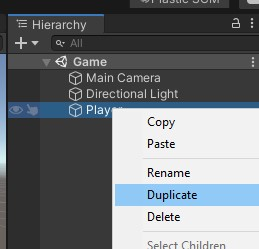
Duplicate existing game object
Change the scale and Material Albedo (color) to recognize the new gameObject from the existing ones. Drag the new Enemy_mat onto the new object in the Hierarchy.
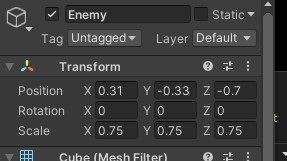
0.75 scale
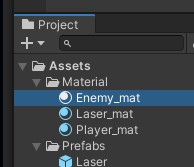
new Material
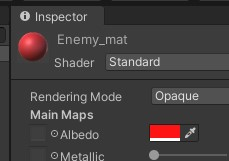
new color, new Albedo
Update the name to Enemy. Here we are adding a new character (gameObject) named Enemy.
Make the new gameObject a Prefab
Enemy is the name of our new object, so drag the Enemy in the Hierarchy down to the Prefabs in the Project Assets.
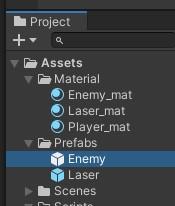
New Prefab
Attach a new Script to the Prefab
Attach to the Prefab, not to the object in the Game Hierarchy. Right click on the Prefab Enemy, Create “C# Script”.
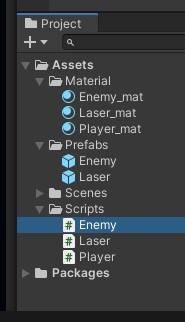
new script
In our example, the Enemy cube was a Duplicate of the Player cube. The player object has Script “Player,” so the Enemy has Script “Player.” The Prefabs object also has Script “Player.”
Remove the Player Script from the Enemy Object (in Hierarchy), click the 3-dot icon to see the menu.
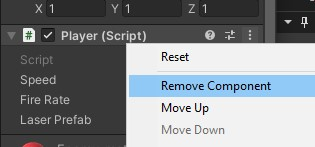
remove Player (Script) component
After removing the Player Script from the Enemy (in Hierarchy), remove the script from the Prefabs after clicking on “Overrides — Apply all.”
Now with the Player Script removed from the Game and Prefabs, drag the Enemy Script onto the Enemy Prefabs.
…(or onto the Game Enemy object and click Overrides — Apply all.)

Enemy Prefab with Enemy Script, C# script
Make sure the Hierarchy Game Enemy has the Enemy Script, and the Project Assets Prefabs Enemy has the Enemy Script.
Add C# Behaviors to Script
Double click the Scripts Enemy to enter Visual Studio and start coding.
Remember to code in the Enemy tab, not the Player or Laser tab.

Enemy tab of Visual Studio
Unity Random Value
The Scripting API is helpful with a float value in a range:
myRandom = UnityEngine.Random.Range(_leftEdge, _rightEdge);
// specify UnityEngine to ovid the conflict with System.Random.Range()
Enabling Unity Physics for Collisions
Objects have a Collider Component. In the component are Trigger and Physic material options. A hard collision happens when two objects meet and stop or bounce off of each other when the Colliders meet. A trigger collision happens when the two Colliders meet and trigger without any physics used to stop or bounce. The trigger then triggers code to handle the meeting of the two objects. The code could be a change in color, a vanishing object, or a addition of the object to an inventory.
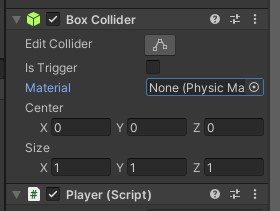
Box Collider component
In this example. The “Enemy” object should disappear after a collision with a “Laser” object. There is no bounce using Collider Physics.

Is Trigger box checked in Collider component
We want a Laser to disappear when colliding with an Enemy. We want a damage count when an Enemy collides with a Player object. All three have the “Is Trigger” box checked. These no-bounce collisions are “pass through” collisions.
In a pass through collision, one of the two objects needs to have a Rigid Body.
Unity has helper methods for collisions, same as how “void Start” and “void Update” are helper methods, inheriting from Monobehaviour
MonoBehaviour
class in UnityEngine
Inherits from:Behaviour
Implemented in:UnityEngine.CoreModule
Description
MonoBehaviour is the base class from which every Unity script derives.
When you use C#, you must explicitly derive from MonoBehaviour.
Deriving from MonoBehaviour allows Unity to issue messages. The important message needed are OnTriggerEnter, OnTriggerStay, OntriggerExit:
OnTriggerEnter
When a GameObject collides with an other GameObject, Unity calls OnTriggerEnter.
Laser collides with Enemy, add a Rigidbody to Laser.
Enemy collides with Player, add same for Enemy.
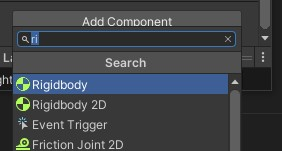
Add Rigidbody component
Uncheck the “Use Gravity” box.
Messaging C# code
public class Enemy : MonoBehaviour
{
private void OnTriggerEnter(Collider other)
{
}
}
When the Monobehaviour sends out the OnTriggerEnter message, “other” will contain the info of “who collided with Enemy.”
“other” is a variable (a parameter); it holds Collider information.
private void OnTriggerEnter(Collider other)
{
Debug.Log("Hit: " + other.transform.name);
}
Here are two Log() messages after a game run to hit the Player with an Enemy, and then hit the Enemy with a Laser

Two Debug.Log messages
Unity has a tool named ‘Tags’ to help with the destruction process.
private void OnTriggerEnter(Collider other)
{
Debug.Log("Hit: " + other.transform.name);
}
Tags let you define objects to go into “other”
(a) highlight Player in Hierarchy. Player Tag Player.
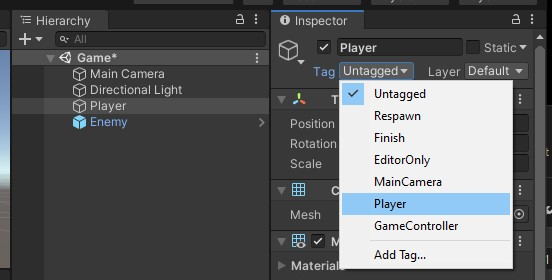
Add Tag Player to Player in Hierarchy
Click icon to add a new Tag for Enemy
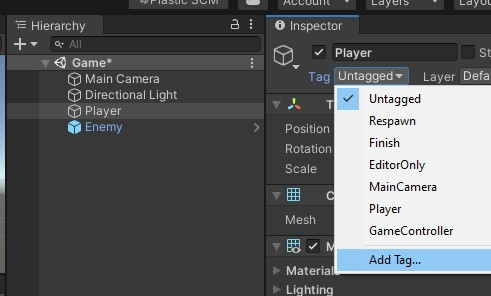
Add a new Tag from Untagged menu
Click “Add Tag…” from Untagged drop down.

Click ‘+’ to type Tag Name
Type in Enemy for New tag name
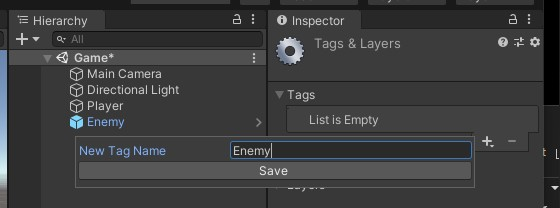
Type in Enemy as New Tag Name
Click Save

Tags list with Enemy
That takes care of object Player. Now Tag Enemy with Enemy.
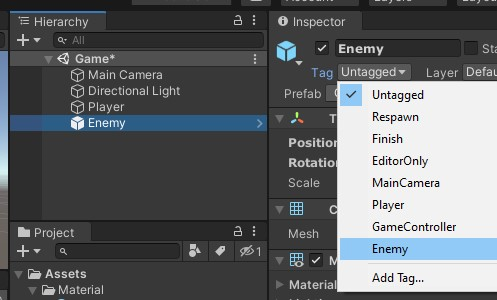
Tag Enemy from Hierarchy with Enemy
And remember to click Overrides All and Save
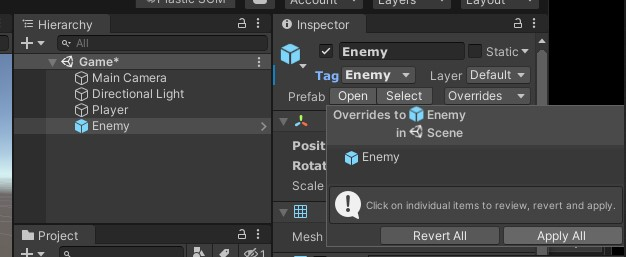
Remember to “Apply All” to Tag “Overrides”
If “Enemy” was deleted from the Hierarchy Game list, then Tag Enemy to Enemy in the Prefabs.
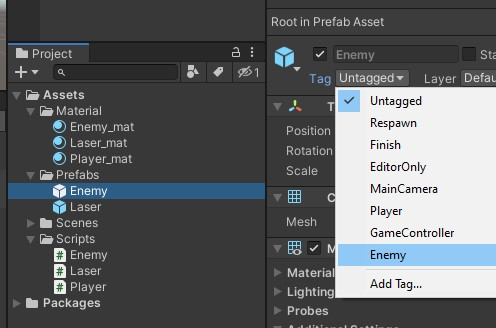
Enemy Tag Enemy from Prefabs
Review Tags

Tags review
And in this example, the same for the Laser in Prefabs.
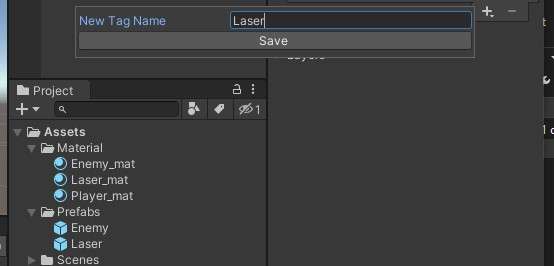
Adding New Tag Name to Laser
Laser appears in the list of Tags.
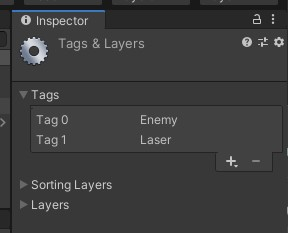
Laser appears in list of Tags
Now Tag Laser (from list) to Laser (the Prefab)
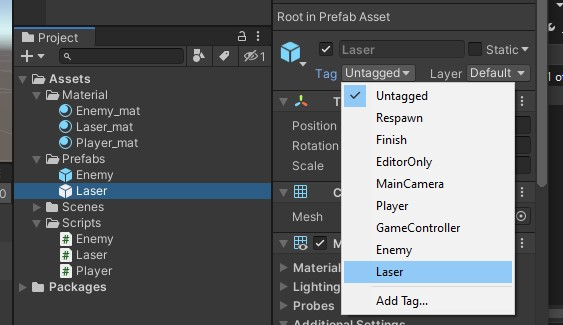
Tag Laser to Laser, from list to object
Here is one way to work with Tag named GameObjects in a script:
public class Enemy : MonoBehaviour
{
private void OnTriggerEnter(Collider other)
{
//Debug.Log("Hit: " + other.transform.name);
// if 'other' contains Player, destroy this (Enemy), damage Player - Player first
if (other.transform.name == "Player")
{
Debug.Log("Hit: Player");
Destroy(GameObject.FindWithTag("Enemy"));
}
// if 'other' contains Laser, destroy this (Enemy), destroy Laser - Laser first
if (other.transform.name == "Laser(Clone)")
{
Debug.Log("Hit: Laser(Clone)");
Destroy(GameObject.FindWithTag("Laser"));
Destroy(GameObject.FindWithTag("Enemy"));
}
}
}
Here is a shorter version using “other.tag”:
public class Enemy : MonoBehaviour
{
private void OnTriggerEnter(Collider other)
{
//Debug.Log("Hit: " + other.transform.name);
// if 'other' contains Player, destroy this (Enemy), damage Player - Player first
if (other.tag == "Player")
{
Destroy(this.gameObject); // Enemy
}
// if 'other' contains Laser, destroy this (Enemy), destroy Laser - Laser first
if (other.tag == "Laser")
{
Destroy(other.gameObject);
Destroy(this.gameObject);
}
}
}